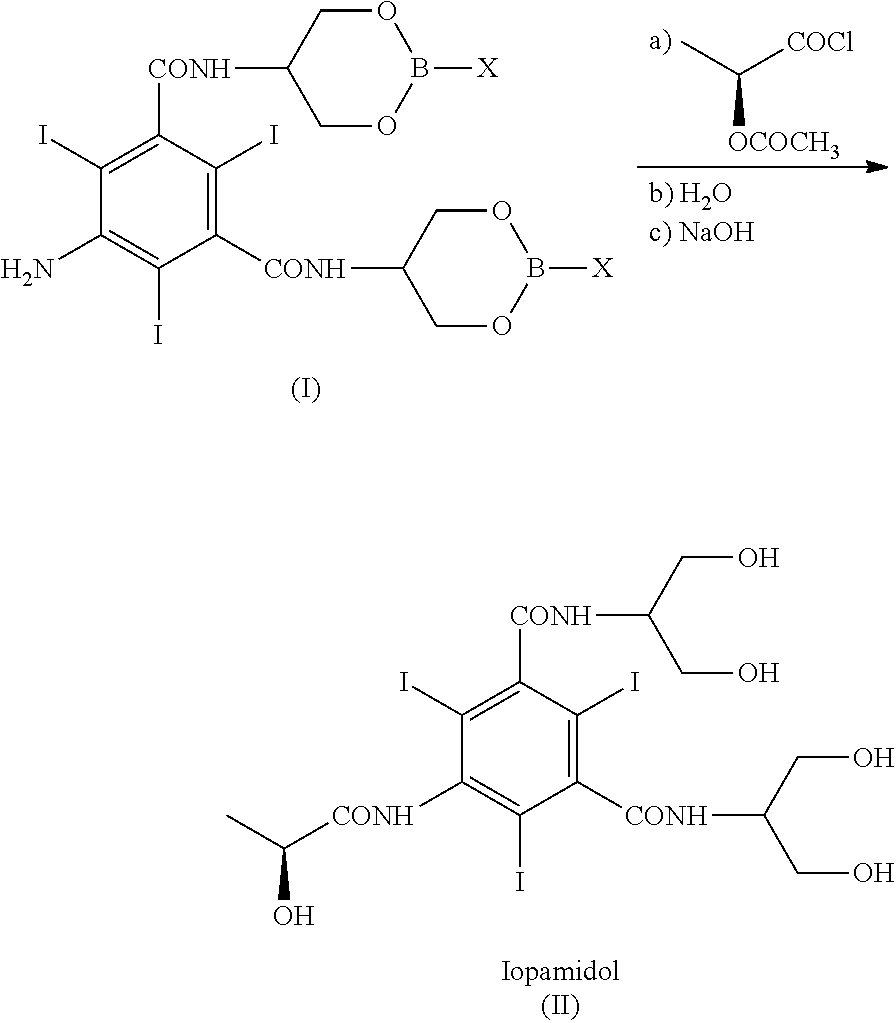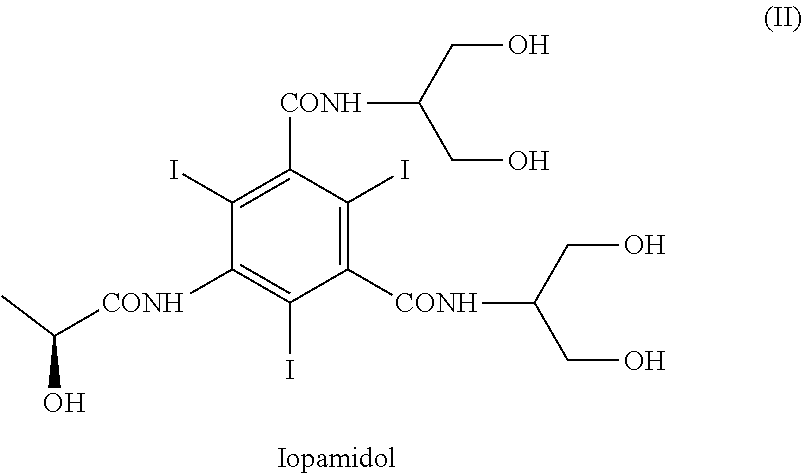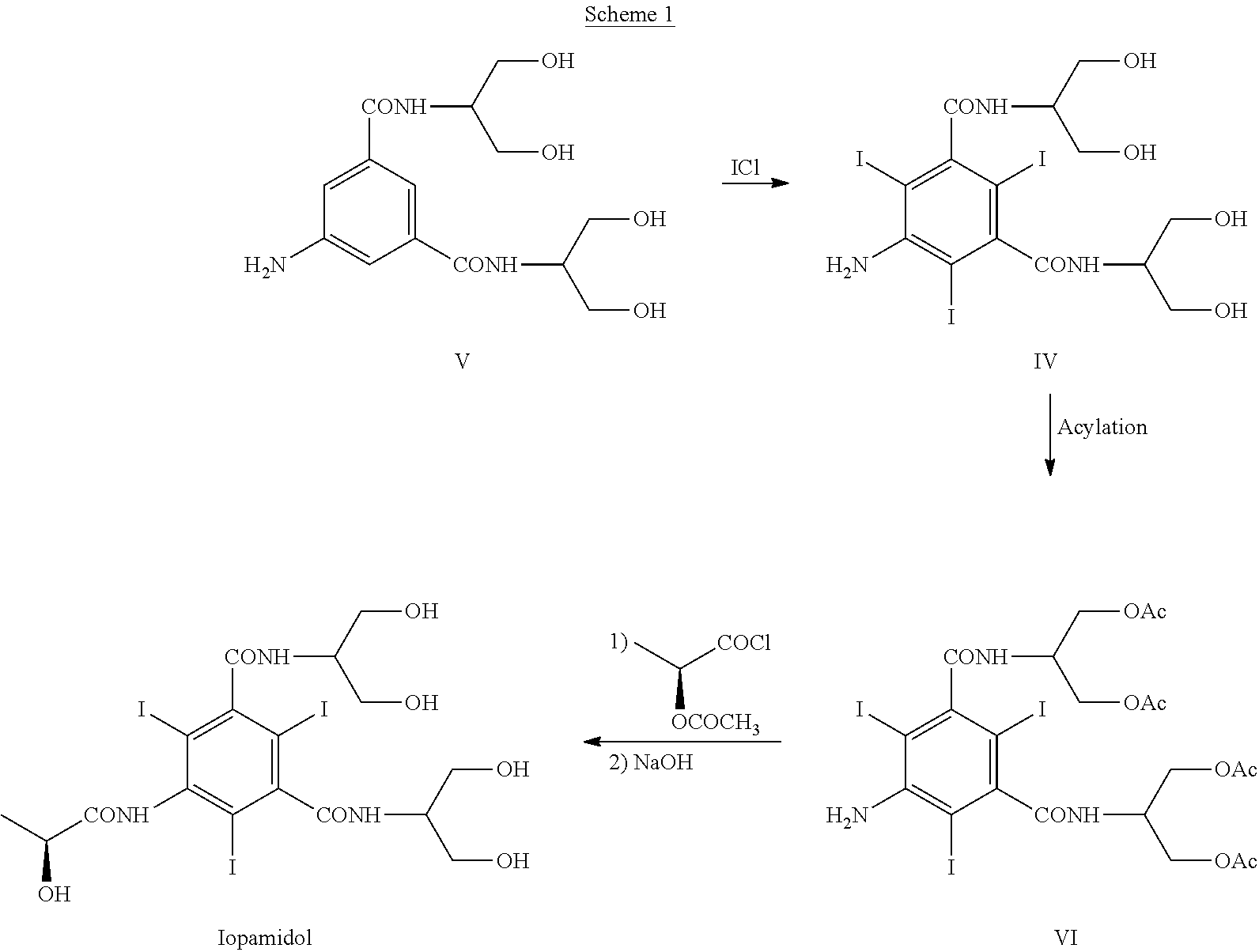Process for the preparation of iopamidol
- Summary
- Abstract
- Description
- Claims
- Application Information
AI Technical Summary
Benefits of technology
Problems solved by technology
Method used
Image
Examples
example 1
Preparation of Iopamidol (II) Starting from Compound (IV) and Using a Boronic Acid
[0144]With reference to Scheme 3, 5-Amino-N,N′-bis[2-hydroxy-1-(hydroxymethy)ethyl]-2,4,6-thiodo-1,3-benzenecarboxamide (IV) (1 kg; 1.42 mol) and phenylboronic acid (X=Ph) (363 g; 2.98 mol) were mixed in N,N-dimethylacetamide (4 kg). The suspension was stirred and heated at 90-95° C. The solution obtained was heated at 90-95° C. for 1 h then N,N-dimethylacetamide (about 3 kg) was distilled under vacuum and brought to a water content lower than 0.5%, assessed by Karl Fischer titration. At this point the formation of intermediate (I) was complete (assessed by 1H-NMR). The residue was cooled to 30-35° C. and, under nitrogen atmosphere, (S)-2-(acetyloxy)propanoyl chloride (380 g; 2.52 mol) was slowly added. The mixture was stirred for 18 h at room temperature and under nitrogen atmosphere then water was added to obtain a diluted solution, suitable for the chromatographic purification. After 1 h of stirring...
example 2
Preparation of Iopamidol (II) Starting from Compound (IV) and Using a Boronic Acid
[0148]Referring to Scheme 3,5-Amino-N,N′-bis[2-hydroxy-1-(hydroxymethy)ethyl]-2,4,6-thiodo-1,3-benzenecarboxamide (IV) (1 kg; 1.42 mol) and phenylboronic acid (X=Ph) (363 g; 2.98 mol) were mixed in N,N-dimethylacetamide (4 kg). The suspension was stirred and heated at 90-95° C. The solution obtained was heated at 90-95° C. for 1 h then N,N-dimethylacetamide (about 3 kg) was distilled under vacuum. The residue should have water content lower than 0.5%, assessed by Karl Fischer titration. At this point the formation of intermediate (I) was complete, as determined by 1H-NMR on an aliquot of the reaction mixture, dried and the residue treated as described below. The residue was cooled to 30-35° C. and, under nitrogen atmosphere, (S)-2-(acetyloxy)propanoyl chloride (384 g; 2.55 mol) was slowly added. The mixture was stirred for 18 h at room temperature and under nitrogen atmosphere then water (9 kg) was add...
example 3
Preparation of Iopamidol (II) Starting from Compound (IV) and Using a Boronic Acid
[0156]Referring to Scheme 3, 5-Amino-N,N′-bis[2-hydroxy-1-(hydroxymethy)ethyl]-2,4,6-triiodo-1,3-benzenecarboxamide (V) (1 kg; 1.42 mol) and phenylboronic acid (X=Ph) (360 g; 2.95 mol) were mixed in N,N-dimethylacetamide (0.76 kg) and methyl isobutyl ketone (MIBK) (3.24 kg). The suspension was stirred and heated at 90-95° C., then MIBK / water mixture (2.8 kg) was distilled under vacuum and brought to a water content lower than 0.5%, assessed by Karl Fischer titration, obtaining a clear yellow solution. At this point the formation of intermediate (I) was complete (assessed by 1H-NMR). The residue was cooled to 30-35° C. and, under nitrogen atmosphere, (S)-2-(acetyloxy)propanoyl chloride (380 g; 2.52 mol) was slowly added. The mixture was stirred for 18 h at 30-35° C. and under nitrogen atmosphere then diluted NaOH solution was added to neutral pH. Another portion of methyl isobutyl ketone (4-5 kg) was ad...
PUM
| Property | Measurement | Unit |
|---|---|---|
| Ratio | aaaaa | aaaaa |
Abstract
Description
Claims
Application Information
 Login to View More
Login to View More - R&D
- Intellectual Property
- Life Sciences
- Materials
- Tech Scout
- Unparalleled Data Quality
- Higher Quality Content
- 60% Fewer Hallucinations
Browse by: Latest US Patents, China's latest patents, Technical Efficacy Thesaurus, Application Domain, Technology Topic, Popular Technical Reports.
© 2025 PatSnap. All rights reserved.Legal|Privacy policy|Modern Slavery Act Transparency Statement|Sitemap|About US| Contact US: help@patsnap.com



